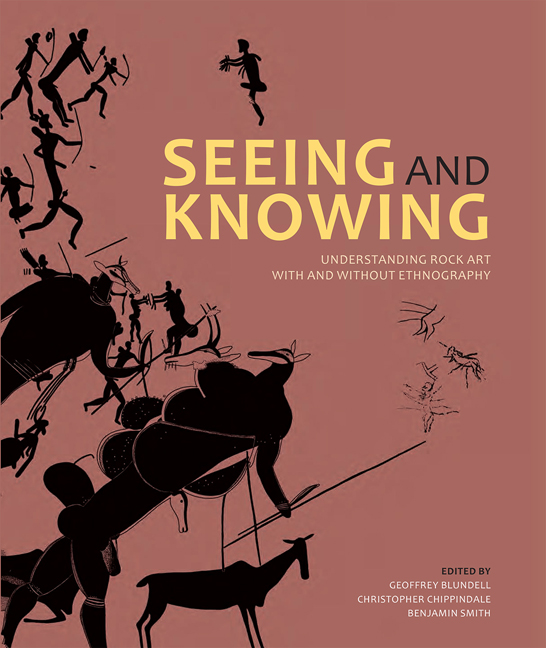Book contents
- Frontmatter
- Dedication
- Contents
- Contributors
- Acronyms
- Chapter 1 Rock art with and without ethnography
- Chapter 2 Flashes of brilliance: San rock paintings of heaven's things
- Chapter 3 Snake and veil: The rock engravings of Driekopseiland, Northern Cape South Africa
- Chapter 4 Cups and saucers: A preliminary investigation of the rock carvings of Tsodilo Hills, northern Botswana
- Chapter 5 Art and authorship in southern African rock art: Examining the Limpopo-Shashe Confluence Area
- Chapter 6 Archaeology, ethnography, and rock art: A modern-day study from Tanzania
- Chapter 7 Art and belief: The ever-changing and the never-changing in the Far west
- Chapter 8 Crow Indian elk love-medicine and rock art in Montana and Wyoming
- Chapter 9 Layer by layer: Precision and accuracy in rock art recording and dating
- Chapter 10 From the tyranny of the figures to the interrelationship between myths, rock art and their surfaces
- Chapter 11 Composite creatures in European Palaeolithic art
- Chapter 12 Thinking strings: On theory, shifts and conceptual issues in the study of Palaeolithic art
- Chapter 13 Rock art without ethnography? A history of attitude to rock art and landscape at Frøysjøen, western norway
- Chapter 14 ‘Meaning cannot rest or stay the same’
- Chapter 15 Manica rock art in contemporary society
- Chapter 16 Oral tradition, ethnography, and the practice of north American archaeology
- Chapter 17 Beyond rock art: Archaeological interpretation and the shamanic frame
- List of figures
- List of tables
- List of publications by david Lewis-williams
- Index
Chapter 9 - Layer by layer: Precision and accuracy in rock art recording and dating
Published online by Cambridge University Press: 21 April 2018
- Frontmatter
- Dedication
- Contents
- Contributors
- Acronyms
- Chapter 1 Rock art with and without ethnography
- Chapter 2 Flashes of brilliance: San rock paintings of heaven's things
- Chapter 3 Snake and veil: The rock engravings of Driekopseiland, Northern Cape South Africa
- Chapter 4 Cups and saucers: A preliminary investigation of the rock carvings of Tsodilo Hills, northern Botswana
- Chapter 5 Art and authorship in southern African rock art: Examining the Limpopo-Shashe Confluence Area
- Chapter 6 Archaeology, ethnography, and rock art: A modern-day study from Tanzania
- Chapter 7 Art and belief: The ever-changing and the never-changing in the Far west
- Chapter 8 Crow Indian elk love-medicine and rock art in Montana and Wyoming
- Chapter 9 Layer by layer: Precision and accuracy in rock art recording and dating
- Chapter 10 From the tyranny of the figures to the interrelationship between myths, rock art and their surfaces
- Chapter 11 Composite creatures in European Palaeolithic art
- Chapter 12 Thinking strings: On theory, shifts and conceptual issues in the study of Palaeolithic art
- Chapter 13 Rock art without ethnography? A history of attitude to rock art and landscape at Frøysjøen, western norway
- Chapter 14 ‘Meaning cannot rest or stay the same’
- Chapter 15 Manica rock art in contemporary society
- Chapter 16 Oral tradition, ethnography, and the practice of north American archaeology
- Chapter 17 Beyond rock art: Archaeological interpretation and the shamanic frame
- List of figures
- List of tables
- List of publications by david Lewis-williams
- Index
Summary
BACKGROUND: informed and formal approaches in conjunction
This chapter deals with the ethnographically informed interpretation and formal stratigraphic recording of the ‘Great Murals’ (Crosby 1984) within Cueva de El Ratón, central Baja California, north-western Mexico (Figure 9.1). The premise of this chapter is that neither informed use of ethnography nor formal archaeological recording can, done in isolation, give an adequate picture of prehistoric rock art (Chippindale & Taçon 1998a), such as evidenced at El Ratón. Albeit essential in any empirical investigation, the mere adoption of rigorous methodologies in both informed ethnographic and formal archaeological studies is not sufficient to guarantee an accurat e picture of the past. It is only when treated in conjunction that informed and formal approaches reach their full potential. Although local ethnographic records are the most logically valid starting points for analogies, the archaeological record is not a one-toone reflection of the ethnography. Demonstrable pattern s observed in the rock art record, for example, sometimes contain information not directly mentioned in the ethnography. Instead of despairing that we cannot interpret the rock art due to a lack of a perfect ‘fit’ with the ethnographic record, such an ostensib le disjunction should be viewed more positively. Indeed, if all rock art neatly reflected the ethnography, then the best we could claim is to have learnt something about the rock art. However, if the rock art reveals convincing bits of information not mentioned in the ethnographic record, then we can rightly claim to have learnt something from the rock art (Inskeep 1971). Herein lies the strength of rock art studies as proposed by David Lewis-Williams (1981) in his seminal Believing and Seeing, in which careful observations of San rock art revealed aspects not always immediately obvious in San ethnography. Ever since his early days of rock art research, Lewis- Williams (1974, 1992) advocated meticulous observation and exploration of patterns, such as super positioning sequences. Nevertheless, as Lewis-Williams has repeatedly stated, meticulous observation alone is not adequate in the absence of a correct understanding of how ethnography and rock art are linked. It is in tribute not only to Lewis-Williams’ insights concerning the subtle and often evasive relationship between ethnography and rock art, but also to his ongoing insistence on close observation and meticulous recording, that I have approached the El Ratón study.
- Type
- Chapter
- Information
- Seeing and KnowingUnderstanding Rock Art With and Without Ethnography, pp. 148 - 167Publisher: Wits University PressPrint publication year: 2010



